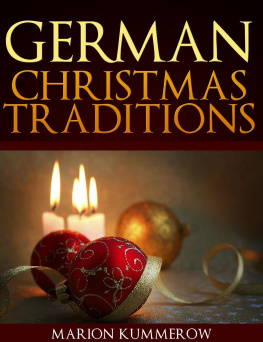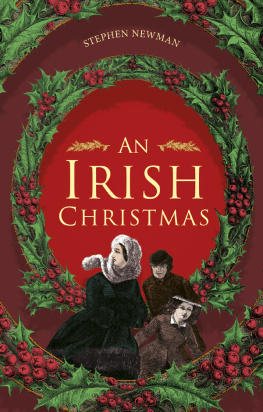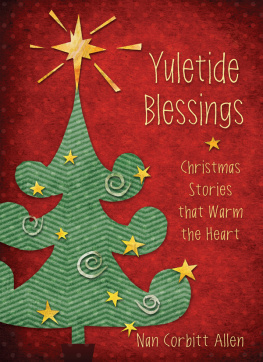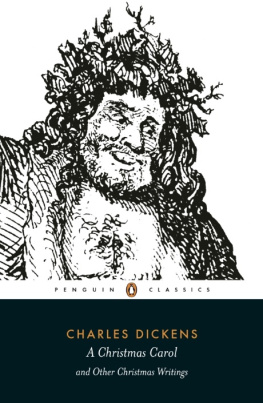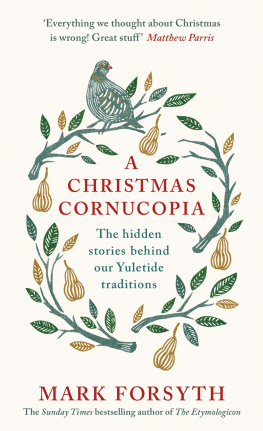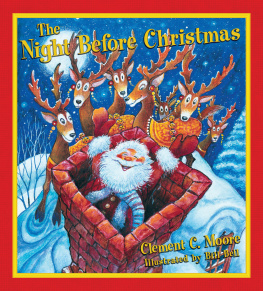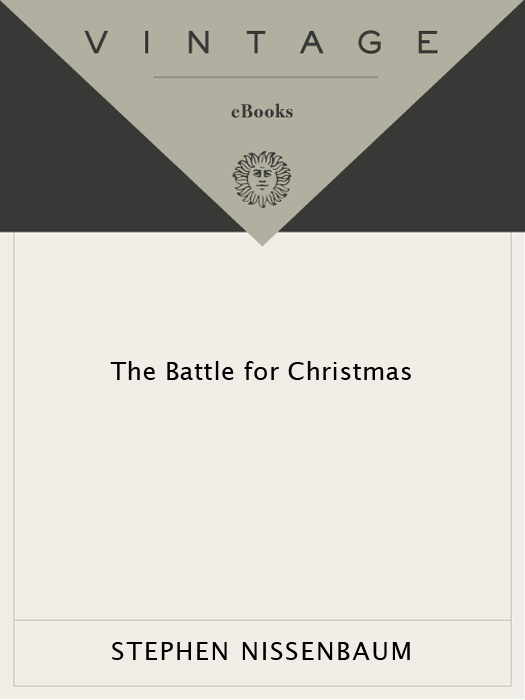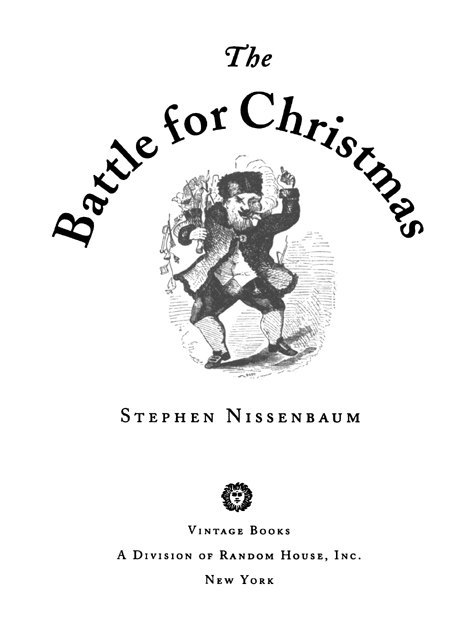Acclaim for S TEPHEN N ISSENBAUMs
The Battle for Christmas
Erudite yet entertaining an unusual history of consumerism an original study.
Boston Globe
A vivid, engaging achievement in social and cultural history. Nissenbaums interpretation of the centuries-long struggle to control and shape our most popular holiday is a revelation. The Battle for Christmas is a rare treat, brilliant and accessible.
Richard D. Brown, University of Connecticut
Refreshingly original and utterly engaging. It is brilliant in conception and astonishing in terms of research.
Michael Kammen, Cornell University
This is cultural history at its most rivetinglively, quirky, insightful. Nissenbaum has a sharp eye for the telling detail, and a keen sense of historical development.
Richard Wrightman Fox, Boston University
Using Christmas as a lens that refracts American social history as a whole, [Nissenbaum] has written a fascinating account that demystifies Christmas and, paradoxically perhaps, humanizes it.
Time Out New York
Like St. Nick himself, Stephen Nissenbaum has brought us a gift that will delight everyone fascinated with the remarkable twists and turns of American culture. In vivid, compelling prose, Nissenbaum shows how the Christmas holiday has carried multiple meanings in our past.
Robert A. Gross, College of William and Mary
The Battle for Christmas renews my faith in Santa Claus, for it tells us who he really is and where he came from. This rewarding book shows that American Christmas was a highly contested holiday long before the Grinch got his hands on it.
Peter H. Wood, Duke University
Full of unexpected revelations about the evolution of Christmas, Nissenbaums book is a stellar work of American cultural history. In probing the historical contexts of Christmas, Nissenbaum casts fresh light on such diverse issues as consumerism, popular culture, class relations, the American family, and the African-American experience.
David Reynolds, Baruch College
Nissenbaums excursion is both enlightening and entertaining in this well-researched book. He travels the centuries with a focus, weaving between the class struggles that define almost every age.
New Jersey Star Ledger
S TEPHEN N ISSENBAUM
The Battle for Christmas
Stephen Nissenbaum received his A.B. from Harvard College in 1961, his M.A. from Columbia University in 1963, and his Ph.D. from the University of Wisconsin in 1968. He has taught at the University of Massachusetts, Amherst, since 1968, and is currently professor of history there. He has been the recipient of fellowships from the National Endowment for the Humanities, the American Council of Learned Societies, the American Antiquarian Society, the Massachusetts Historical Society, and the Charles Warren Center at Harvard. In addition, he was James P. Harrison Professor of History at the College of William and Mary, 198990. Active in the public humanities, he has served as member and president of the Massachusetts Foundation for the Humanities, and as historical advisor for several film productions. The Battle for Christmas was a Pulitzer Prize finalist in History in 1997.
A LSO BY S TEPHEN N ISSENBAUM
Salem Possessed:
The Social Origins of Witchcraft (with Paul Boyer, 1974)
Sex, Diet, and Debility in Jacksonian America:
Sylvester Graham and Health Reform (1980)
The Pursuit of Liberty:
A History of the American People (with others, 1984, 1990, 1996)
EDITOR
The Great Awakening at Yale College (1972)
Salem-Village Witchcraft:
A Documentary Record of Local Conflict in Colonial New England (with Paul Boyer, 1972, 1993)
The Salem Witchcraft Papers:
Verbatim Transcripts of the Legal Documents of the Salem Witchcraft Outbreak of 1692 (with Paul Boyer, 1977)
Nathaniel Hawthorne, The Scarlet Letter and Selected Writings (1984)
FIRST VINTAGE BOOKS EDITION, NOVEMBER 1997
Copyright 1996 by Stephen Nissenbaum
All rights reserved under International and Pan-American Copyright Conventions. Published in the United States by Vintage Books, a division of Random House, Inc., New York, and simultaneously in Canada by Random House of Canada Limited, Toronto. Originally published in hardcover in the United States by Alfred A. Knopf, Inc., New York, in 1996.
Grateful acknowledgment is made to MCA Music Publishing, Inc., for permission to reprint an excerpt from Christmas Tree Blues, words and music by Charley Jordan, copyright 1935 by MCA Music Publishing, Inc., a division of MCA, Inc., copyright renewed. All rights reserved. International copyright secured. Used by permission.
The Library of Congress has cataloged the Knopf edition as follows:
Nissenbaum, Stephen.
The battle for Christmas / Stephen Nissenbaum. 1st ed.
p. cm.
eISBN: 978-0-307-76022-7
1. ChristmasUnited StatesHistory. I. Title.
GT4986 . AIN57 1996
394.26630973dc20 96-22355
Random House Web address: http://www.randomhouse.com/
v3.1_r3
For
William R. Taylor
My teacher
Preface
T HIS BOOK had its beginnings more than twenty years ago, when I delivered a speculative scholarly paper titled From The Day of Doom to The Night Before Christmas. In that paper I dealt with the striking parallels between the best-known American poem of the 1600s and 1700s and the best-known American poem of the 1800s and 1900s. The earlier poem was about Gods wrath, the later one about the goodwill of Santa Clausbut somehow the two were engaging in a kind of dialogue with each other.
Actually, though, it is clear that the book began earlier still, with my childhood fascination for The Night Before Christmas, whose verses I recited over and over when December came around. For me, growing up as I did in an Orthodox Jewish household, this was surely part of my fascination for Christmas itself, that magical season which was always beckoning, at school and in the streets, only to be withheld each year by the forces of religion and family. (I once decided that Christmas must mean even more to Americas Jewish children than to its Christian ones.) I can remember, one Christmas Day, putting some of my own toys in a sack and attempting to distribute them to other children who lived in my Jersey City apartment house: If I couldnt get presents, at least no one stopped me from giving them away, and in that fashion at least I could participate in the joy of what, much later, I would come to think of as the gift exchange.
Much later came soon enough. By the late 1980s I had been a professional historian for some twenty years, and I was also regularly engaging in the nonacademic aspects of my trade. In 1988 I found myself involved in the development of a teacher-training program sponsored by Old Sturbridge Village, the living-history museum in central Massachusetts. The theme we decided to focus on with the teachers (they taught grades 38) was holidays. Remembering that paper I had written more than a decade earlier, I figured young children might be intrigued by seeing unfamiliar things in A Visit from St. Nicholas, that most familiar of poems. (Mama in her kerchief and I in my cap ? Away to the window and threw up the sash ? A



